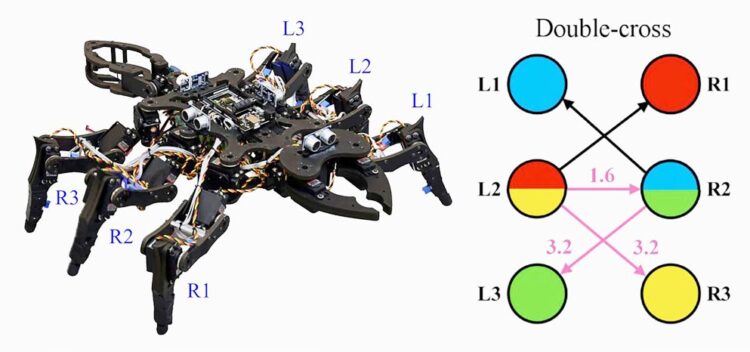‘Chaotic’ way to create insectlike gaits for robots

Researchers in Japan and Italy are embracing chaos and nonlinear physics to create insectlike gaits for tiny robots -- complete with a locomotion controller to provide a brain-machine interface. View of their experimental robot and coupling schemes for its gaits.
Credit: Ludovico Minati
By using small networks of Rössler systems, a locomotion controller enables a brain-machine interface for a six-legged antlike robot.
Researchers in Japan and Italy are embracing chaos and nonlinear physics to create insectlike gaits for tiny robots — complete with a locomotion controller to provide a brain-machine interface.
Biology and physics are permeated by universal phenomena fundamentally grounded in nonlinear physics, and it inspired the researchers’ work.
In the journal Chaos, from AIP Publishing, the group describes using the Rössler system, a system of three nonlinear differential equations, as a building block for central pattern generators (CPGs) to control the gait of a robotic insect.
“The universal nature of underlying phenomena allowed us to demonstrate that locomotion can be achieved via elementary combinations of Rössler systems, which represent a cornerstone in the history of chaotic systems,” said Ludovico Minati, of Tokyo Institute of Technology and the University of Trento.
Phenomena related to synchronization allow the group to create very simple networks that generate complex rhythmic patterns.
“These networks, CPGs, are the basis of legged locomotion everywhere within nature,” he said.
The researchers started with a minimalistic network in which each instance is associated with one leg. Changing the gait or creating a new one can be accomplished by simply making small changes to the coupling and associated delays.
In other words, irregularity can be added by making individual systems or the entire network more chaotic. For nonlinear systems, a change of output is not proportional to a change of input.
This work shows that the Rössler system, beyond its many interesting and intricate properties, “can also be successfully used as a substrate to construct a bioinspired locomotion controller for an insect robot,” Minati said.
Their controller is built with an electroencephalogram to enable a brain-computer interface.
“Neuroelectrical activity from a person is recorded and nonlinear concepts of phase synchronization are used to extract a pattern,” said Minati. “This pattern is then used as a basis to influence the dynamics of the Rössler systems, which generate the walking pattern for the insect robot.”
The researchers tap into the fundamental ideas of nonlinear dynamics twice.
“First, we use them to decode biological activity, then in the opposite direction to generate bioinspired activity,” he said.
The key implication of this work is that it “demonstrates the generality of nonlinear dynamic concepts such as the ability of the Rössler system, which is often studied in an abstract scenario,” Minati said, “but is used here as a basis to generate biologically plausible patterns.”
###
The article, “Generation of diverse insect-like gait patterns using networks of coupled Rössler systems,” is authored by Shunki Kitsunai, Woorim Cho, Chihiro Sano, Supat Saetia, Zixuan Qin, Yasuharu Koike, Mattia Frasca, Natsue Yoshimura, and Ludovico Minati. The article will appear in Chaos on Dec. 15, 2020 (DOI: 10.1063/5.0021694). After that date, it can be accessed at https:/
ABOUT THE JOURNAL
Chaos is devoted to increasing the understanding of nonlinear phenomena in all areas of science and engineering and describing their manifestations in a manner comprehensible to researchers from a broad spectrum of disciplines. See https:/
All latest news from the category: Power and Electrical Engineering
This topic covers issues related to energy generation, conversion, transportation and consumption and how the industry is addressing the challenge of energy efficiency in general.
innovations-report provides in-depth and informative reports and articles on subjects ranging from wind energy, fuel cell technology, solar energy, geothermal energy, petroleum, gas, nuclear engineering, alternative energy and energy efficiency to fusion, hydrogen and superconductor technologies.
Newest articles

Sea slugs inspire highly stretchable biomedical sensor
USC Viterbi School of Engineering researcher Hangbo Zhao presents findings on highly stretchable and customizable microneedles for application in fields including neuroscience, tissue engineering, and wearable bioelectronics. The revolution in…

Twisting and binding matter waves with photons in a cavity
Precisely measuring the energy states of individual atoms has been a historical challenge for physicists due to atomic recoil. When an atom interacts with a photon, the atom “recoils” in…

Nanotubes, nanoparticles, and antibodies detect tiny amounts of fentanyl
New sensor is six orders of magnitude more sensitive than the next best thing. A research team at Pitt led by Alexander Star, a chemistry professor in the Kenneth P. Dietrich…





















